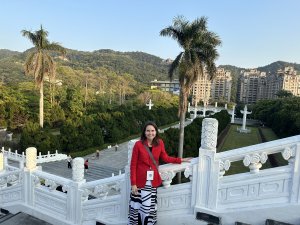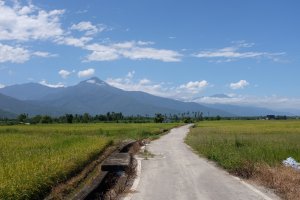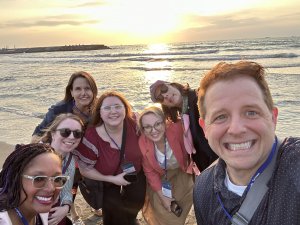For my Fulbright grant I chose a topic of immense richness: the aboriginal peoples of Taiwan. What I found exceeded my every expectation. I have experienced countless encounters and exchanges, celebrated the sacred rites and important dates of the harvest and hunting calendars of the Pangcah (also known as Amis), the Paiwan, the Atayal and Saisiyat peoples. My Fulbright grant became a mixture of scholarship and art.
To begin at the beginning: I became aware of the cultural and artistic vitality of Taiwan during a short visit in 2005; and at that time I also began to learn about the Taiwanese aboriginals. I started to look into their origins. The scholarship is extensive and the science is far from settled, but everyone agrees that 9 out of the 10 branches of the Austronesian languages are spoken on Taiwan, and that the ‘Yuánzhùmín’, 原住民, the original people, have been living on Taiwan for at least 8 thousand years.
Genetic and linguistic linkages establish a connection between the ‘Yuánzhùmín’ of Taiwan to other groups from Madagascar to New Zealand, Easter Island, the Philippines and greater Polynesia. Competing models of a “Slow boat” or an “express train” to Polynesia are used by anthropologists to model these connections. The science is developing rapidly, particularly in the area of mitochondrial DNA and Y chromosome tracking and complete genetic sequencing of genomes. Whatever theory you subscribe to, Taiwan’s original inhabitants and their astonishing diversity, have now been reduced to a mere 2 % of the Taiwanese population.
I came this year to Taiwan to experience the present history of these people. As a theater artist, the state of the art technology, the artistic freedom and the cultural richness come together at the highest level in Taiwan, furnishing limitless possibilities. This is what inspired me to live and write and teach in this culture.
My good friend and co-teacher of the Ritual and Theatre course at Taipei National University of the Arts, Professor Mingder Chung, combines a lifetime of scholarship in Theater Anthropology and Performance Studies with a deep and abiding spirituality. Taimu, as everyone calls him, is perhaps unique in this combination of qualities, and throughout my grant he proved a matchless guide. He shared decades of experience and longstanding relationships with key members of the tribes.
Together with TNUA graduate students, we joined and celebrated Maljeveq, the Paiwan ceremony held every five years, and the bi-annual Saisiyat PaSta’ay ceremony of atonement. This amounted to weeks away from the University, engaged in active field studies preceded by careful readings, lectures, presentations and class discussions on the nature of the ceremonies we were about to join. Always the objective was an engaged scholarship involving full participation in the rites and practices we were studying.
I also received important assistance from the Asian Cultural Council / Taiwan with introductions to members of the Pangcah tribe along the Pacific Coast of Taitung County. Indeed, my name Yi Guang Hai 易光海,comes from those experiences among the Pangcah people in the Makutaay, the place where the river flows from the mountains to meet the sea: the mixing.
The work was exhaustive and illuminating and nothing in terms of time or effort was spared. Fieldwork is fascinating because you never end up where you think you will. The first choice of words always ends up being inadequate. I often had the feeling that a new language to represent a new way of thinking is needed to fully capture the depth, nuance and complexity of the practices we encountered. Words like paradox failed utterly.
Tradition itself is a complex of meanings which develops over time; even as it remains steady and true to itself, it does not change. Tradition is always mindful of present surroundings and so, because of its shifting environment without variation in practice it changes to meet the need, in a kind of muscular lifting up or decisive pushing back against a changing world. The sense of belonging to the present and the past is indomitable.
The PaSta’ay ritual of the Saisiyat people over time acquired additional meanings during the colonization/occupations of the Dutch, Qing, Japanese and KMT periods of governance. While the ancient ritual itself was viewed differently by each of these powerful cultures, each of whom identified their priorities and set forth programs in an effort to exert their dominance and sense of superiority over the Saisiyat people, the tradition proved itself durable and resistant. The PaSta’ay is a three-day song cycle of atonement and purification where people come together to dance. It is a complex pilgrimage of forgiveness that takes place in a single location. Let me wonder aloud about those who came believing they were more civilized than forgiveness.
The power in aboriginal traditions is in how they bend (and blend) but do not break. It is a resilience that in the end allows them restore their practices, to outlive and out last those who came to change them.
A word about methodology.
The methodology is to believe, to trust and to accept the invitations of the ‘Yuánzhùmín’ to understand. My approach is a methodology that does not mean ‘going native’ and disremembering the basic human facts of my origins. It is a decisive middle ground of equality. We do not abandon what we know; neither do we place ourselves somewhere above in any scheme of social evolution. I believe in this balance, for we have tremendous gifts to give and so do the ‘Yuánzhùmín’; it is a meeting, a mixing and it takes time. As you can see I am a patriot of the Saisiyat people and I will return to them shortly.
I began with the Amis, or, as they prefer to be called, Pangcah people. They live on Taiwan’s east, Pacific, coast, where I participated in the Ocean Festival and experienced my first island earthquake, a small tremor, and a minor typhoon. The men went out fishing all night in that storm to collect the richness of the sea and the next morning to make offerings of thanks to the ocean for its power and abundance. At the Ocean Festival I sat with my age mates. The ocean that sustains them also takes their lives.
The Pangcah is a large tribe, the largest on the island, and there were many notable artists and famous singers in attendance at the festival. After the offerings were made, it was the privilege of these celebrity Pangcah to be singled out to serve the ocean feast to those above them in the hierarchy. It is good to be old. It is good to be successful and make the tribe proud.
I returned many times to this area of Shitiping along the Pacific coast celebrating the Moon Festival and the rice testing ceremony. It is a matrilineal society and the women, besides taking the lead in activism and social movements, also make all important family decisions. The painter and installation artist Sumi Dungi was in her fourth year of a campaign to restore rice farming to the pacific costal area; and in so doing, to return meaning to the harvest festivals and to protect the dignity of the land from development. Hers is a steady heroism. Now Pangcah school children learn the basics of rice farming in the fields the county government once paid the Pangcah not to farm. As a result of this decades-long policy the land has avoided the pesticide boom that affected productive agricultural land virtually everywhere else on the planet. The land is pure and by agreement will remain so; and the people are farming again. The harvest is real and shared out among the families of the people who work the land as it always has been worked.
You see the power of a woman’s single-minded vision when she believes “you can do anything.” When I think of the phrase Contemporary Aboriginal I think of Sumi Dungi and her “wish of the ocean rice”, a wish now fulfilled. When I think of the phrase Contemporary Aboriginal I think of Miyang, my Pangcah guide and friend who signed up for the military at age 16 and served Taiwan for well over a decade. The martial aspect of the tribe is as important as any other single feature. Miyang knew the history going back more than 200 years and he, as much as anyone, taught me what it meant to be an aboriginal man today; to know and remember and to make his own way.
Before our Ritual and Theatre class went to the Wufeng Township for the PaSta’ay, we traveled south to Pingtung County for the Paiwan 5 year Maljeveq ceremony: the festival of the covenant. Some of the best Paiwan singers are in their eighties and nineties, and they can sing hundreds of songs from memory. We find that among the Paiwan the ultimate responsibility and authority in the family for carrying on tradition falls to the firstborn child, whether male or female. We are not in a simple patriarchy.
In a tribe that honors royalty, the king may ride up on a motor scooter and carry his own bags. And so it was with us and our audience with Paiwan Chief Lin Kuang Cai, Negerenger Lin. What was to have been a one hour exchange lasted over 5 hours and was interrupted only by the peaceful setting of the sun. Chief Negerenger Lin is given the responsibility of caring for and preserving in his memory all of Paiwan musical and spoken culture. It is his job to speak it, to sing it, to keep it alive in the ambitious heart of his people. He admires Ray Charles and wanted to exchange songs; to hear our songs. When I sang one from south Texas bluesman Huddie Ledbetter (Lead Belly), Chief Lin asked if I heard the blues in his singing and I agreed with him, in all sincerity, that the blues are as much a feeling as an approach to melody. “Many of our songs”, he said, “don’t have words, they are sounds but not words. It really is about the feeling.” And then he sang a wordless song.
The Paiwan Maljeveq ceremony takes place only every 5 years and lasts for several days. Unlike the PaSta’ay which takes place on reserved ground, the Maljeveq now takes place in the city itself. Pingtung shuts down the length of one road which is cleaned and opened to accommodate the tables for food and drink and the large numbers of Paiwan, many of whom travel great distances to join the ceremony. The royalty sit at the tables in the center of the circle and the mass of Paiwan begin to sing.
They make a linked line which turns into an increasingly elongated circle, stretching several blocks, as more and more join throughout the night. In this circle, the eight-step dance form is always progressing, one step at a time, to the right, so that while you are linked arm and arm with the people on either side, you are also moving steadily to the right. Facing you, eight yards away and across the street, the other side of the circle is progressing in the opposite direction: to its right. It goes this way all night, so as you make the full round, you see everyone up close again and again. The old singers you sat with in the afternoon are there with you in the line in the evening, glad to know you have joined them.
Some parts of the Maljeveq that are entirely taboo, are reserved for the initiated only, but the spirit on the public nights is one of inclusion. Together we mark the renewal of the covenant between the Paiwan and creation.
2014 was an auspicious year, since it featured both the celebration of the Maljeveq rites of the Paiwan, the second most populous tribe of Taiwan, and the celebration of the PaSta’ay of the Saisiyat, who are one of the smallest of the tribes. Both are traditionally mountain peoples. The Northern Saisiyat mingle with the Atayal tribe and the Southern Saisiyat with the Hakka people. The Saisiyat language is endangered. All Saisiyat speak several languages: Atayal, Hakka, Taiwanese Hokkien and Mandarin. Many Saisiyat intermarry with other groups and many live and work outside of their home area in the major cities of Taiwan. The PaSta’ay is a chance for them to come together, exercise their language and express their religion.
Originally a yearly celebration, during the 50 years of the Japanese rule the practice was initially banned and later subject to restrictions. The result is that it is now performed every second year. When I asked the elders about this, they said that it was fine to do it every 2 years, since it takes months to prepare and the people are busy with their work. In 1936 a team of Japanese ethnographers carefully filmed the ritual in its entirety. This priceless record is clear evidence that the ceremony is virtually unchanged, despite rapid modernization and the tumultuous political, linguistic and social changes that have occurred in the ensuing 78 years. The resilience of oral traditions and religious practices seems unquestionable. In this way the culture of peoples on the margins of written histories endures.
While histories are written by victors, revised by others, and burned by successors; faith, songs and stories go on. If you care enough, you can step off the page and be invited to join in this the great mainstream of history.
The source and purpose of the PaSta’ay is atonement. The Saisiyat identify themselves as the first of the original people in Taiwan. The Atayal and other mountain tribes moved in later. Before all these peoples were the Ta’ay, a tribe of short dark-skinned people who were in the mountains when the Saisiyat arrived. These people were nimble, very clever and excellent singers. The Ta’ay gave land, shared their technology, agricultural, hunting and healing, sheltered and taught the Saisiyat the names of each mountain and place, the rivers, the valuable plants, and all the ways needed to survive in the mountains. In thanks the Saisiyat would invite the Ta’ay to join them in their harvest festivals; and it was here, following a harvest festival that all but two of the Ta’ay were killed in a single act by a Saisiyat man. The two that survived were very old.
The PaSta’ay, literally “the beseeching of the Ta’ay”, is the rite of atonement taught to the Saisiyat by these two surviving Ta’ay, so that the Saisiyat people might be able to properly ask for forgiveness for this terrible act. As the consequences of their actions are eternal, they must revisit the crime and renew their atonement for all time. This observance follows the songs and rites taught to them by these two surviving Ta’ay, who later traveled east to join their tribe-mates as spirits: the kokota’ay.
All my life I have heard stories of the Great Potato Famine, the Holocaust, the Disappearances of the South American dictatorships. I underwent my formative years under the system of racial segregation in the American South. That this list is of such magnitude and points seemingly in all directions is the crux. Such terrible things are at the center of what drives human events. For private individuals a good apology is hard to find, rarer still is forgiveness. For nations, supposedly the highest expression of our humanity, it is virtually impossible to find. Then there are the Saisiyat.
Other tribes in Taiwan have accounts of short dark-skinned people who once lived among them. For them these are often-repeated colorful stories. The Saisiyat believe. And it is here, if we look at the cultural forensics of human experience, that we can see truly what is within reach for all of us.
I came to Taiwan as an artist and my form of expression is performance. I wrote a play during my time here that in personal ways, the ways of private individuals, touches on forgiveness. It is not a story of nations or even my own story. It is a story of individual causes that live everywhere, of refusal, possibility and ambivalence. It is a theater of images that uses a collage of stories to tell of connected lives, a song cycle of images and sounds, a memory play of sorts, written in close up. It has been translated into Mandarin and the plan is to perform it for both the English- and the Chinese-speaking markets.
When languages are endangered words matter. Of the 26 known aboriginal languages of Taiwan, at least 10 are extinct, 5 are moribund and several others are listed as endangered. It is often said that when languages die something irretrievable is lost. We must be mindful of this price of modernization. Do we truly progress with this loss to our species, we who have come so far? And are these losses necessary, especially considering that each and every one of us is capable of speaking many languages? The dominion and obvious utility of common languages should not, to my way of thinking, mean the death of others.
The declining birth rate in Taiwan, taken together with public health issues of exceedingly high rates of infant mortality among aboriginal people, as well as the dramatically high rate of premature and accidental death for their elders, constitute calls for action. Taiwan’s universal national health care system has helped greatly, but more can be done. Systems that protect the most vulnerable in society provide better protection for everyone. No new programs need to be invented. Concrete proven steps in Public Health are available to us now to turn this around.
The preservation of languages starts with the young; schools such as those in Hawaii which have turned around the almost certain extinction of the Hawaiian language are tried and true, and can serve as models for Taiwan. It gives utility to the elders and educates and removes the sense of loss for the young.
We can see the possibilities. We can see a social evolution leading us to equality, towards the wealth of diversity and appreciation of all the living voices of those who have come before.
Truly, the greatest part of my Fulbright is still ahead. I have reserved time later this year to stay on for interviews with Saisiyat elders; I am writing a chapter on an Atayal artist for a book “Chinese Woment in the Arts” that is coming out later this year, and in 2016 there is the promise of the production of the play I wrote here at my host institution the Taipei National University of the Arts.





